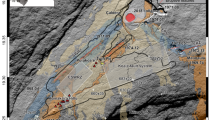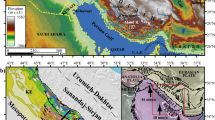Summary
The present study aims at making a contribution to the tectonics of the Western Himalayan Regions of Jammu, Kashmir and Ladakh. During the summer of 1978, the orientation of many joints has been measured in outcrops along the road from Jammuvia Srinagar to Leh. Based upon the contention that the visible rock-joints are shear surfaces produced by the neotectonic stress field, the principal stress directions of the latter can be calculated from a statistical analysis of the orientations of the joints. Furthermore, it has also been proposed that many valley trends follow tectonic shear zones. Thus, a statistical evaluation of the valley trends in Jammu and Kashmir has been made. The analysis of the orientations of joints and river valley trends has shown that, in both these features, there are two pairs of conjugate systems of directions. The first, the preponderant one, has preferred pole directions of N 55°E and N 138°E; it is produced by a principal horizontal compression with an azimuth of N 7°E. The second system is only vestigially developed in the joints, it has preferred pole-azimuths around N 92°E and N 358°E. Field evidence shows joints belonging to this second system to terminate at joints belonging to the first (preponderant) system which permits one to infer that the second system is older than the first and, thus, belongs to previous orientation of the tectonic stress field. In the valleys, both systems are almost equally well developed which indicates that earlier orientations are preserved in valleys for a longer time than in joints. The orientations of the neotectonic stress field deduced from joint-orientation measurements are in good conformity with the ideas of plate tectonics. Thus, India “pushes” (or is dragged) northward; the joints are slip surfaces fitting into this pattern.
Zusammenfassung
Die vorliegende Studie hat den Zweck, einen Beitrag zur Tektonik der westlichen Himalaya-Regionen von Jammu, Kashmir und Ladakh zu leisten. Während des Sommers 1978 wurde die Orientierung vieler Klüfte in Aufschlüssen längs der Straße von Jammu über Srinagar nach Leh gemessen. Aufgrund der Annahme, daß die sichtbaren Felsklüfte Gleitflächen des neotektonischen Spannungsfeldes darstellen, ist es möglich, die Hauptspannungsrichtungen aus den Kluftstellungen mit einer statistischen Methode zu berechnen. Weiters wurde auch schon der Ansatz gemacht, daß die Talrichtungen ebenfalls neotektonischen Gleitzonen entsprechen. Somit wurde auch eine statistische Analyse der Talrichtungen von Jammu und Kaschmir gemacht und mit den Kluftstellungen verglichen. Es ergab sich, daß sowohl bei Klüften als auch bei Talrichtungen zwei Paare je zueinander konjugierter Richtungssysteme existieren. Das erste ist vorrangig; es zeigt Polrichtungen von N 55°E und N 138°E, was einer Hauptdruckspannung in Richtung N 7°E entspricht. Das zweite Paar ist bei den Klüften nur spärlich entwickelt; es hat Polazimute von N 92°E und N 358°E. Feldbeobachtungen zeigen, daß dieses zweite System durch das erste, vorrangige, begrenzt ist, so daß es als älter gelten und daher einer früheren Orientierung des tektonischen Sapnnungssystems entsprechen muß. Bei den Tälern sind beide Richtungspaare vorhanden, was bedeutet, daß die älteren Orientierungen hier länger konserviert werden als bei den Klüften. Die Orientierung des neotektonischen Spannungsfeldes, wie es aus den Kluftstellungen abgeleitet wurde, ist in guter Übereinstimmung mit den Vorstellungen der Plattentektonik. So schiebt sich Indien nordwärts; die Klüfte sind Gleitflächen, die in dieses Schema passen.
Similar content being viewed by others
References
Billington, S., Isacks, B. L., Barazangi, M.: Spatial Distribution and Focal Mechanism of Mantle Earthquakes in the Hindu-Kush Pamir Region. Geology5, 699–704 (1977).
Frank, W., Gansser, A., Trommsdorf, V.: Geological Observations in the Ladakh Area (Himalayas): a Preliminary Report. Schweiz. Min.-Petr. Mitt.57, 89–113 (1977).
Gansser, A.: Geology of the Himalayas. 289 pp. London: Interscience 1964.
Gansser, A.: The Great Suture Zone Between Himalaya and Tibet. In: Colloques Internationaux de la Recherche Scientifique No. 268: Himalaya, Publ. by Centre National de la Recherche Scientifique Paris, p. 181–191, 1977.
Kohlbeck, F., Scheidegger, A. E.: On the Theory of the Evaluation of Joint-Orientation Measurements. Rock Mech.9, 9–25 (1977).
Molnar, P., Chen, W. P., Fitch, T. J., Tapponier, P., Warsi, W. E. K., Wu, F. T.: Structure and Tectonics of the Himalaya: A Brief Summary or Relevant Geophysical Observations. In: Colloques Internationaux de la Recherche Scientifique No. 268: Himalaya. Publ. by Centre National de la Recherche Scientifique Paris, p. 269–294, 1977.
Raina, A. N.: Geography of Jammu and Kashmir. 1st ed., New Delhi: National Book Trust 1971.
Raina, A. N.: Geography of Jammu and Kashmir. 2nd ed., 271 pp. New Delhi: National Book Trust 1977.
Scheidegger, A. E.: The Enigma of Jointing. Rock Mech. (In press.)
Author information
Authors and Affiliations
Additional information
With 14 Figures
Rights and permissions
About this article
Cite this article
Scheidegger, A.E. On the tectonics of the Western Himalaya. Arch. Met. Geoph. Biokl. A. 28, 89–106 (1979). https://doi.org/10.1007/BF02316319
Received:
Issue Date:
DOI: https://doi.org/10.1007/BF02316319




